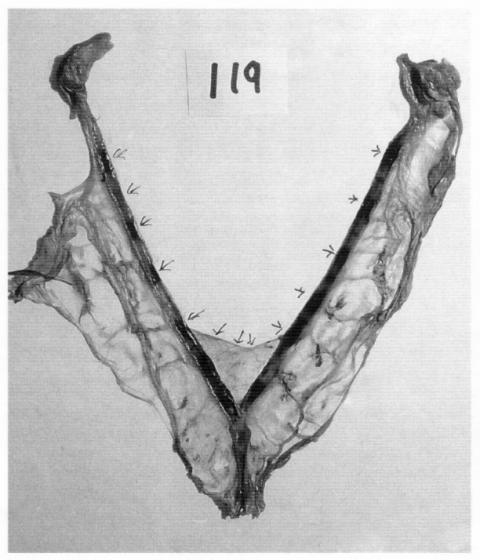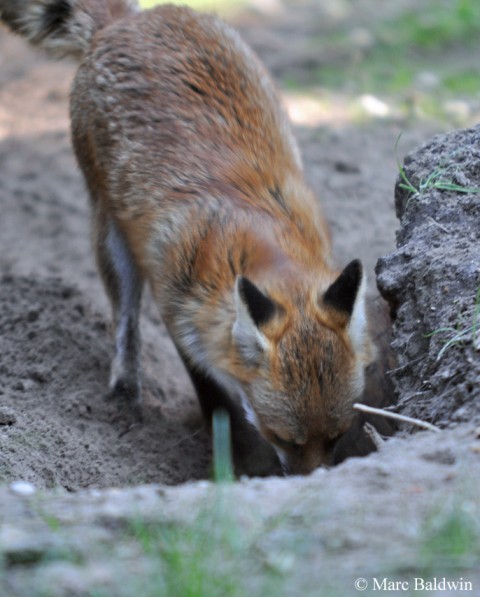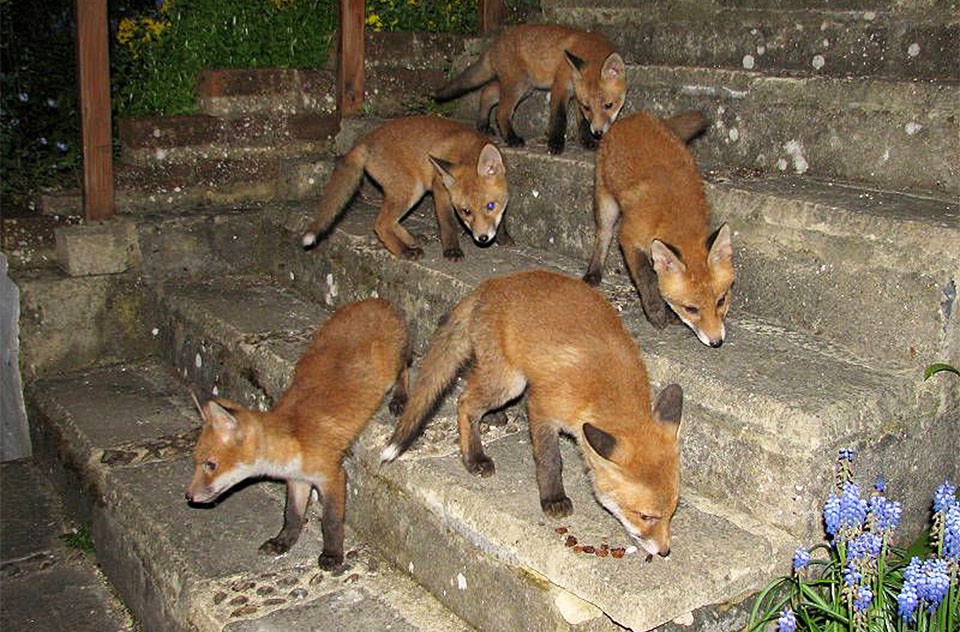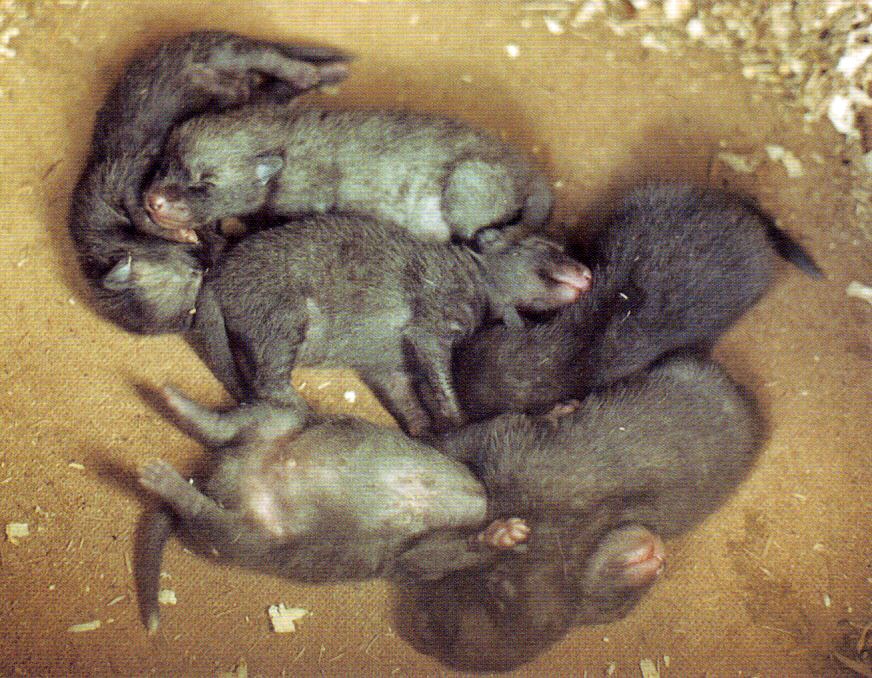How Many Babies Does a Fox Have in a Litter
Most successful matings will occur during tardily January or early Feb (September and October in Australia) and, following successful fertilization, embryos enter the uterus nearly five days after mating and implantation occurs 5 to 16 days later, when progesterone levels (need to sustain pregnancy) are at their peak. Bold successful implantation, the vixen will begin a gestation (pregnancy) that can concluding betwixt 49 and 58 days; typically, Scarlet foxes gestate for 52 days (around seven.v weeks or just under ii months). Co-ordinate to Mark Cardwine, in his 2007 Beast Records book, Cerise foxes take the shortest gestation of the dogs – domestic dogs, by comparison, gestate for 58 to 65 days, African wild dogs (Lycaon pictus) for 69 to 73 days and bat-eared foxes (Otocyon megalotis) for between 60 and 75 days.
Foetuses can exist lost at any time betwixt conception and birth and, if this happens, they are then re-captivated; this is a normal part of fox (indeed mammal) reproductive biology. In Wales, Huw Gwyn Lloyd plant that an average of about 10% of pregnancies didn't arrive to term, although in some years this reached 22% while in others losses were negligible. We can become an indication of how many foetuses make it to term and how many are resorbed by looking at the vixen'southward uterus. Like most mammals, foxes course a placental connection to their young and these connections to the uterus go out their marks. Indeed, since at least the 1930s we have known that scars on the uterus lining tin can exist used to estimate successful births in mammals. The technique has been used in foxes since at to the lowest degree 1949, when New York biologist William Sheldon used the technique on American Red and grayness foxes (Urocyon cinereoargenteus).

In a 2000 publication for the Game and Wildlife Conservation Trust, Jonathan Reynolds summarised the topic of placental scar counting in Cerise foxes. Reynolds described how, mail service-mortem, the scars on the uterus—each of which signify the site of a developing foetus—can be used to assess litter size. Dark scars are left by the placenta in one case it has asunder from the uterus and indicates a successful birth; allowed cells chosen macrophages migrate to the disconnection site and begin breaking down the blood, leaving haemosiderin and lipids, which give the scar its color. If the foetus is resorbed all that persists is a faint (pale) scar on the uterus marking its position.
In theory, counting the number of dark and light scars on a uterus should tell yous how many ova successfully implanted and the number that made it to birth. In practise, all the same, this requires practise and it can frequently be hard to distinguish aborted foetuses from the scars from the previous year'southward births (which fade in fourth dimension and may persist for longer than traditionally believed). Such counts can besides overestimate litter size because information technology cannot distinguish live and withal births, or between births and very belatedly-term abortions. Information technology can, all the same, often exist used to good upshot and, in 1970, Jan Englund developed a greyscale calibration (with six shades) to distinguish active (nascence) from sometime (previous births) or resorbed scars.
Over subsequent years, various authors have improved upon the method and, in 2011, French biologists Sandrine Ruette and Michel Albaret published an improved method that involved staining the scars. With this they were able to positively identify scars relating to successful births (and less ambiguously than using a colour bill of fare), but couldn't separate previous births from abortions. Additionally, the timing of collection tin can accept an bear on and, in his comprehensive review of the Red fox in Ireland, published in 1970, University College Galway zoologist James Fairley noted that placental scars had disappeared by belatedly proestrus, presumably because new endometrial tissue grows during this period, covering them over. In the finish, it is the number of immature born that interest those involved in fob conservation and management and hence such methods are aimed at addressing this.
In his fascinating 2000 book, My Life with Foxes, the late New Wood naturalist Eric Ashby described how the signs of pregnancy are not immediately obvious in vixens, with the size and shape of the mother beingness only slightly altered past the tiny unborn cubs. It seems that the first indication is an increment in ambition, followed by a surge in the hormone prolactin which causes the teats to swell and change from their pale colour to be brilliant pink and prominent - simultaneously, the fur around the teats becomes blank.

The natal earth
Bold all's well, the vixen's mammary glands sally nearly two weeks earlier the immature are due to be born and, at around the same time (late Feb), the vixen becomes extremely secretive as she starts looking for an earth in which to give birth (a natal earth). She may dig a new earth, or use a previous one – underneath sheds and out-buildings are pop natal earth sites, as are sites under gravestones (encounter Dens/Earths). Ashby noted that his male fox, the father of the cubs, became very attentive soon before the cubs were born – following the vixen virtually everywhere, sleeping abreast her and bringing her presents of food and toys.
In most habitats, the only period during which a den is most essential is the breeding season. In some cases a fox will requite birth above ground in the trunk of a fallen tree, a tussock of grass or in a log pile, but such instances are rare. Where an al fresco nascence does happen, information technology may accept been that the vixen was forced to leave the earth for some reason and was "caught brusque". Indeed, in Running with the Fox, David Macdonald described finding five mole-grey newborn foxes nestled cosily in a dry out tussock of reeds bordering a duck pond. Later that night, having disturbed the vixen, Macdonald watched her move the youngsters to a nearby earth under an oak tree.
About foxes, it seems, are born underground. In the days leading up to and following nascency, the vixen is typically sustained by nutrient brought to her by the father and, in some instances (equally we'll come up on to soon), subordinate vixens in the social group. The vixen generally does not allow the domestic dog access to the young while they remain in the earth (the showtime sight he manifestly gets is when they appear above ground) and he leaves food at the entrance. No scats will be deposited in the vicinity of the earth during this fourth dimension.
Family planning - litter size
The largest unconfirmed litter I take come across is xiv immature—usually called cubs (UK) or kits (US), but occasionally pups—and while there is a confirmed example of a vixen from Tippecanoe Canton in Indiana having thirteen cubs, the mixing/pooling of the litters of two or more than vixens in a social group may account for many such large counts. We don't know how frequently vixens pool litters, although we doubtable it's more likely in resources-arable urban settings. A significant difference in the size of cubs accompanying a vixen is oftentimes taken equally evidence of litter pooling, but Huw Lloyd, in his 1980 opus The Red Play tricks, described the case of a captive vixen whose litter of four cubs he observed at about four weeks quondam. Two of the cubs looked similar month-old foxes, while the other ii were much less well developed and had the advent of younger animals. Removal of the larger cubs from the vixen for a couple of hours a day resulted in the smaller cubs quickly catching up their littermates. Lloyd cautioned that:
"Had this litter been establish in the wild, it would probably have been regarded as prove of the pooling of 2 small litters, the appearance of the two larger and two smaller cubs being so different."
Too equally litter pooling, in that location are anecdotal reports of cubs existence adopted. In July 2021, a lady in Kent reported 8 well-grown pull a fast one on cubs feeding together in her garden. According to her observations, this family started out with 4 cubs, which grew to five equally a different cub, darker in colour and much bolder (due east.g. didn't await for the adult vixen to swallow first, similar the other cubs, and of which the other cubs seemed nervous) turned up on 10th June. From five, the litter increased to eight and the observer's opinion is that the family unit is essentially fostering these other cubs, rather than them beingness part of the same litter but not having put an appearance in until now. The cubs are all around the same size/age going by the photos. In a slightly more extreme example, during a deterrence check at a battered stable building in March 2021, four cubs of conspicuously different ages were institute together in the same den site; ii were near a calendar week old and two four or five times larger at an estimated 3 weeks one-time. In this case, only 1 developed was ever seen going into the stable (although it should be cautioned that this doesn't exclude the presence of a second individuals that evaded observation) and it remains unknown which litter belonged to the electric current mother - she appeared to be caring for both, though. The cubs were removed the mean solar day after her visit, the observer presumes by the same vixen.

Vixens typically have iv pairs (eight) of mammae (nipples), although equally many as x have been reported, suggesting they would struggle to raise very big litters. Indeed, Lloyd was certain that a wild fox can't successfully nurse a litter of more than x cubs unaided.
The average litter contains four to six cubs, with viii being the largest that a single vixen in the Uk is likely to produce. Interestingly, litter size is relatively constant across years and it seems that fifty-fifty where foxes are heavily controlled (causing a reduction in the population density) the population responds by increasing the number of vixens breeding, rather than past increasing the number of cubs in the litters. This makes sense when we consider that culling reduces density and increases the number of bachelor territories, meaning information technology is easier for a play a joke on to strike out on its own and free herself from the convenance suppression imposed by her female parent. Hence, more vixens have litters, while litter size itself is correlated with the concrete size (not necessarily weight) of the vixen, which is independent of available territory. That said, in that location are some information to suggest that the number of cubs in the litter tin also vary according to habitat.
Experiments past a grouping of scientists based in Spain, for example, found that foxes in the "vegas" (their term for favourable habitat) had larger litter sizes than those in the "steppe" (less favourable habitat). The vegas population also had a higher number of arid vixens than the steppe—19.3% and 1.7%, respectively—which presumably reflects breeding suppression by dominant vixens in favourable habitat. Similarly, an outbreak of rabbit haemorrhagic disease in Espana during 1988 caused a substantial (xc%) decline in rabbit numbers—the staple food of these foxes—and acquired a refuse in the average litter size that ultimately led to a reduction in pull a fast one on abundance.
Boxing of the sexes
Interestingly, habitat quality doesn't only impact the number of breeding vixens on a territory; it tin also influence the sex ratio of the litter and this, in turn, can touch on the appointment the cubs are built-in. Nosotros now know that mothers invest more energy producing males than females and vixens living in loftier quality habitat tend to exist larger than those in poorer areas, putting them in a better position to cope with the higher energetic demands of male person cubs: these individuals thus tend to produce more male cubs (although they don't have larger litters), while smaller vixens tend to produce more than female person cubs.

For many years we have known that male cubs are typically born larger than vixens (dogs were 11.4% heavier than vixens in one written report of Welsh 45 litters by Huw Lloyd), which implies that even in the womb the mothers are feeding their male cubs more than female ones. During his studies of foxes in Wales, Lloyd too recorded an interesting shift towards male cubs as gestation progressed. Lloyd looked at the sex ratio of 333 embryos from 68 litters and establish that early in gestation the sex ratio was slightly female biased (with 48.ix% being male person), just by the fourth dimension the mothers were xl days from giving nativity the ratio had shifted slightly in favour of males (51.5%). This shift isn't huge (only ii.6%), but it does suggest that male embryos accept a higher survival rate than female ones; in an article to the July 2012 issue of BBC Wild fauna Magazine, Stephen Harris goes a scrap further, suggesting that vixens may preferentially abort female embryos.
Recent work at Bristol University past Helen Whiteside has establish that the number of males in the litter also has a bearing on when the vixen gives nativity. Logically, you could be forgiven for expecting that litters with more dogs than vixens should be born earlier, assuasive more than time for the male person cubs to abound and prosper, but quite the opposite is observed, as Harris explained in the aforementioned article. During her Ph.D. studies, Whiteside found that male-dominated litters were born later than vixen-dominated ones; this allows the cubs to be weaned at the point that their main prey (rabbits and voles) showtime breeding and should thus mean an affluence of solid food for them. If the cubs are born early on, they're weaned before this mammal 'overabundance' and are more dependent on earthworms and insects in the interim, which are less predictable. If it is a hot, dry out summer these invertebrates are hard to find and this can severely impact the growth of the cub.
Cubs reach their developed size by the autumn, so they can't 'brand up' for any growing lost through a dry out summer and, thus, having a bountiful supply of young mammals to fall back on can make all the departure. Male cubs, information technology seems, grow faster than females both when suckling and when weaned on to solid food. Why should this exist of import? As we'll see later, size is of import for males (larger cubs become larger adults that are more probable to find and keep a territory and thus more than likely to father more cubs than smaller males). For females, size doesn't have the aforementioned implications in afterwards life and a small-scale vixen is just as probable to breed equally a larger 1.
Dropping litter. When are cubs born?
The height time for births in the Uk is mid-March, although cubs tin be built-in any time from late January until well into Apr. There are fifty-fifty a few very early records. although confirmed records remain rare. Brian Vezey-Fitzgerald, recorded fob cubs above ground in his garden on 5th January 1963, during the very harsh wintertime with thick snowfall cover; working backwards, this suggests they were born in early on December and that the was vixen fertilized in October. Additionally, a fox cub was brought into The Fob Project on 25th February 2013; it was estimated to be about four weeks quondam on admission and is therefore likely to take been born in late January. In his book, Town Play a joke on, Country Fox, Vezey-Fitzgerald went on to describe how there was more than variation in cub births in Europe:
"… in French republic and Belgium, births of wild fox cubs have been recorded in every month of the year except August: even births in June and July are not regarded as altogether exceptional."

In the Great britain, the latest litters tend to be born during April and, given the spontaneous nature of the Ruddy play a joke on'southward convenance biology, I more often than not treat unverified reports of very late play tricks cubs with considerable suspicion. That said, a fox cub estimated to be only three-weeks-onetime was taken in by South Essex Wildlife Hospital on 19th November 2013, after information technology was found in cardinal London with no globe in sight. This represents that latest verified UK nascence I have come across and, working backwards, suggests birth during the last week of Oct and successful mating around the 9th September.
Births in the U.k. announced to coincide with populations elsewhere in Europe. In a recent paper to Mammalian Biology, Zea Walton and Jenny Mattisson used GPS fixes to calculate that the peak fourth dimension for cubs to exist built-in by xxx collared vixens in Sweden and Norway was betwixt 20th March and 14th May, with the average being the twelfth Apr.
I would be very interested to hear from readers who accept evidence of very early or late fox litters. In Australia, where seasons are reversed compared with the northern hemisphere, nearly mating occurs during June and July and play tricks cubs are typically built-in during August and September.
Source: https://www.wildlifeonline.me.uk/animals/article/red-fox-breeding-gestation-birth-litter-size
0 Response to "How Many Babies Does a Fox Have in a Litter"
Post a Comment